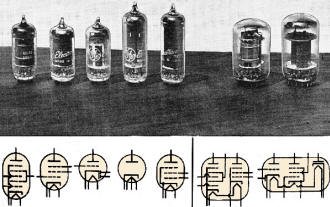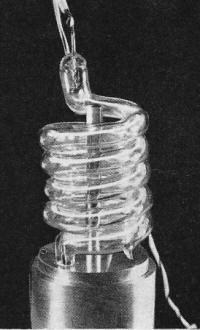|
September 1960 Radio-Electronics
 [Table of Contents] [Table of Contents]
Wax nostalgic about and learn from the history of early electronics.
See articles from Radio-Electronics,
published 1930-1988. All copyrights hereby acknowledged.
|
The advent of missiles
and nuclear warheads which can fly long distances and be virtually unstoppable once
launched (intercontinental ballistic missiles,
ICBMs)
came online shortly before this "Accurate Missile Tracking" item appeared in a 1960
issue of Radio-Electronics magazine. NATO and Warsaw Pact nations raced
to develop both offensive and defensive systems to help be able to defend itself
against aggressors. The Cold War
was on. Eventually, all sides either unilaterally or multilaterally possessed enough
nuclear warheads - and the ability to deliver them - to cause everyone to fear what
would happen in the aftermath of a global nuclear war, with radioactive fallout
settling all over the globe. While that scenario is undesirable, an unexpected outcome
was the Mutual Assured Destructions (MAD) philosophy
whereby the primary deterrent against an attack was that such an action would prompt
an immediate full-scale counterattack against the aggressor(s). That suffices until
religious fanatic countries like Iran acquire nuclear capability and wouldn't hesitant
to strike in spite of MAD, since they believe their actions will accord them rewards
in the afterlife. Since the 1990s, the U.S. has abetted Iran in multiple ways in
acquiring nuclear capability. Do a little research on administrations providing
cash, material, technology, and material for doing so.
New Briefs:
11/57 |
8/58 |
11/59 |
2/60 |
4/60 |
8/60 |
9/60 |
10/60 |
12/60 |
1/61 |
3/61 |
5/61 |
6/61 |
7/61 |
8/61 |
9/61 |
10/61 |
11/61 |
12/61 |
1/62 |
2/62 |
3/62 |
4/62 |
5/62 |
7/62 |
8/62 |
9/62 |
3/63 |
4/63 |
8/63 |
9/63 |
3/64 |
8/64 |
12/64 |
1/67 |
3/67 |
4/67 |
5/67 |
6/67 |
9/67 |
4/68 |
9/68
News Briefs
 Accurate Missile Tracking Accurate Missile Tracking
A missile tracking system, so accurate that its most serious errors are due to
our not knowing the exact speed of light, will be built near Cape Canaveral by General
Electric. The MISTRAM system (MISsile TRAjectory Measurement system) is designed
to determine, with extreme accuracy, the guidance performance of missiles fired
from the Cape.
 The basic system, which should be completed
and in operation by January, 1962, will consist of a group of five receiving stations
arranged in an L (see diagram). Antennas at the five stations (one central station
and four remotes) will follow the flight of a missile and receive signals from a
radio beacon in the missile. Measurements will be made on a CW carrier to get an
exact indication of phase difference of extremely high-modulation frequencies. The basic system, which should be completed
and in operation by January, 1962, will consist of a group of five receiving stations
arranged in an L (see diagram). Antennas at the five stations (one central station
and four remotes) will follow the flight of a missile and receive signals from a
radio beacon in the missile. Measurements will be made on a CW carrier to get an
exact indication of phase difference of extremely high-modulation frequencies.
The range measured by the central station using these signals, and that from
each remote is used to determine the position of the missile.
The unusual part of the MISTRAM system is that it does not require huge tracking
antennas since azimuth and elevation data can be derived by computers' from the
range and range-difference in-formation.
Three Tubes in One Envelope
 A new group of electron instrumentalities
made by G-E combine the functions of up to three separate tubes in a single 12-pin
envelope. These Compactions will make possible size and price reductions in radios,
TV's, hi-fi sets and many other types of electronic equipment. For an example of
Compactron savings see the photo. The two units on the right replace the five standard
radio tubes on the left, and represent a saving in cost, size and operating power. A new group of electron instrumentalities
made by G-E combine the functions of up to three separate tubes in a single 12-pin
envelope. These Compactions will make possible size and price reductions in radios,
TV's, hi-fi sets and many other types of electronic equipment. For an example of
Compactron savings see the photo. The two units on the right replace the five standard
radio tubes on the left, and represent a saving in cost, size and operating power.
Development engineers at G-E also said that other circuit elements could be included
in evacuated Compactrons, giving a hint of a receiver where all smaller components
(resistors and capacitors) would be combined with tubes in plug-in packages.
Laser-A Light Amplifier
 The first device actually to amplify visible
light was announced by Dr. Theodore H. Maiman of Hughes Aircraft. He developed the
laser (light amplification by stimulated emission of radiation) that does the amplifying.
The device could be used as a light radar that would use light waves (up to 500,000
billion cycles) in place of microwaves. Another possible application is in TV and
voice communications where the needle-sharp beam (if projected from the earth to
the moon the beam would spread to only 10 miles in diameter) offers a static-free
line that resists jamming. The high resolution due to its sharp beams permits detailed
pictures of any area - a must for satellite reconnaissance. The first device actually to amplify visible
light was announced by Dr. Theodore H. Maiman of Hughes Aircraft. He developed the
laser (light amplification by stimulated emission of radiation) that does the amplifying.
The device could be used as a light radar that would use light waves (up to 500,000
billion cycles) in place of microwaves. Another possible application is in TV and
voice communications where the needle-sharp beam (if projected from the earth to
the moon the beam would spread to only 10 miles in diameter) offers a static-free
line that resists jamming. The high resolution due to its sharp beams permits detailed
pictures of any area - a must for satellite reconnaissance.
The unit shown consists of a powerful flash tube that illuminates a synthetic
ruby rod. The green flashes of light from the lamp excite the atoms in the ruby
rod to a higher energy state. The energy is re-radiated in a narrow band of frequencies
as they return to their original state. The excited atoms are coupled to an optical
resonator and stimulated to emit their radiation simultaneously, unlike ordinary
light sources where the atoms radiate individually at random.
Two-Color TV for Japan
A Japanese TV manufacturer is planning to put a two-color-system color set on
the market in Japan. Mr. Saburo Soda, president of the Chuo Musen Co., Tokyo, claims
that the cost of the set will be about one-third that of a standard three-color
set.
The set converts the ordinary three-color signal to a two-color signal. It is
then fed to a black-and-white picture tube. To get color effects, a two-color wheel
(red and green) is spun in front of the tube face. The reproduced colors are said
to be not as natural as those obtained on a standard receiver, but they are "at
least serviceable." Adjustments and maintenance are said to be easier.
While two-color TV systems have been demonstrated in the past, Mr. Soda made
it clear that his is an independent system, developed on a theory put forward by
a Tokyo engineer on the basis of the two-color theory announced last year by Dr.
Edwin Land of the Polaroid Corp.
Asks 50 Satellites
A plan calling for placing about 50 communications satellites in orbit has been
presented to the FCC by the Bell Telephone System. The satellites, spaced about
3,000 miles apart, would provide communication facilities between the US and all
other world areas. In most instances, a direct hookup could be made with no intermediate
stations in any other country. The proposal indicated that the Bell system would
expect to share in the cost of the program.
The best frequencies for space use would be between 1,000 and 20,000 mc. "Our
future in world communications and our future in the exploration and exploitation
of space depend on the wise use of the very limited range of frequencies in the
electromagnetic spectrum which is suitable for satellite communication and for other
space purposes," Mr. James B. Fisk, president of Bell Telephone Laboratories, said.
Posted July 23, 2024
|



























 Accurate Missile Tracking
Accurate Missile Tracking


